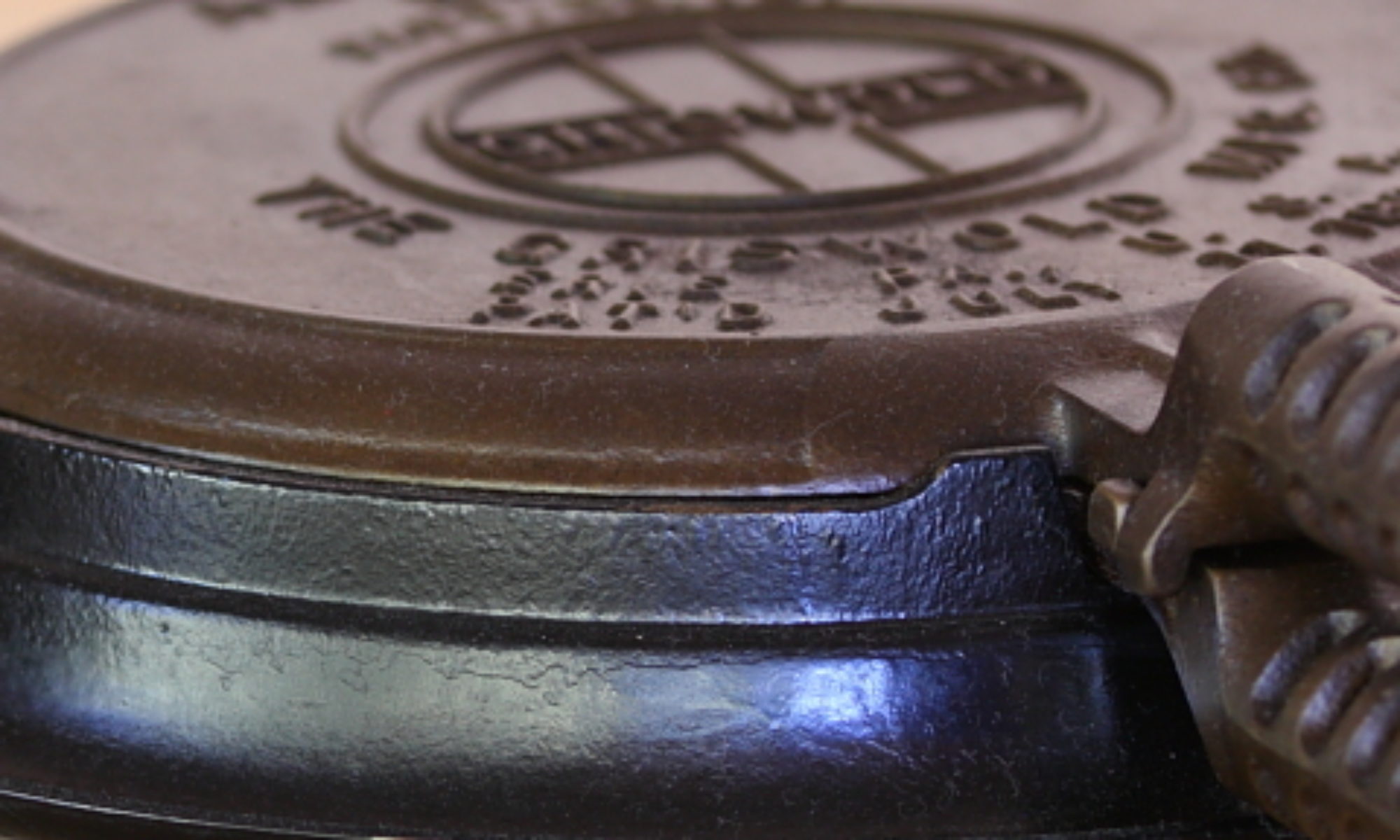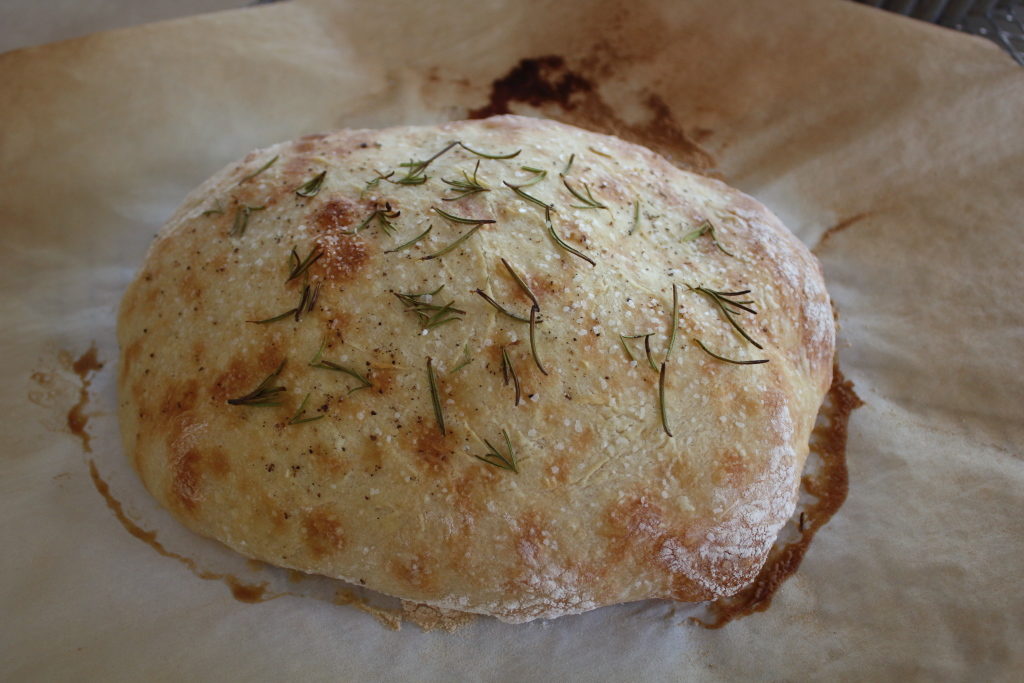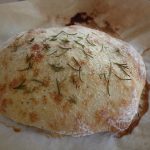
When we first tried this bread, we made it using commercial yeast, and we said that we’d show you how to make the same bread using a sourdough starter. Today, we will. And, if you’re one of those people who bake with sourdough starters, you know that you need to feed and split your starter regularly, including those times when you don’t feel like baking a full batch of bread. Well, it turns out that this bread is perfect for just those occasions, as you can use the starter that you’d normally discard.
This is the same recipe as Pizza Bianca alla Romana, which we learned from Jim Lahey at the Tucson Festival of Books, only using sourdough starter in place of yeast. And, here, we use leftover sourdough starter, too. The stuff that you might discard after feeding your starter, so now you’ll never have to toss starter again.
Sourdough Pizza Bianca alla Romana
Ingredients
- 280 g sourdough starter
- 260 g water
- 260 g all-purpose flour
- 4 g salt
- 4 g sugar
- Extra-virgin olive oil
- 2 sprigs rosemary
- Freshly ground black pepper
- Kosher salt for sprinkling
Instructions
- In the bowl of a stand mixer fitted with the paddle attachment, combine sourdough starter and water. Mix on low until soupy.
- Add flour, salt, and sugar, and mix, starting on low and increasing speed to medium until the batter pulls away from the sides of the bowl, about 5-7 minutes.
- Cover bowl and let rise until doubled, about 2 hours.
- Place a baking stone on the middle rack of your oven and preheat to 450°F.
- Heavily dust a work surface with flour and turn out dough. Divide dough in two, and fold up the corners to tighten the dough. Flip and transfer to a floured piece of baking parchment.
- Brush top of bread with olive oil, sprinkle with rosemary leaves, black pepper, and kosher salt.
- Use a pizza peel to slide onto the baking stone, and bake until golden browned on the top, about 15 minutes.
Ingredient discussion:
If you’re using a sourdough starter, we’ll also assume that you use a scale, so, below, we’ll show you how to tailor this recipe to your starter. It’s easy. You want a good olive oil here, as it’s for flavor. We used 100% all-purpose flour this time, but you could use a mix of all-purpose and whole wheat, too.
Procedure in detail:
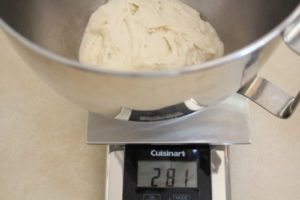
Weigh starter. Okay, we’re assuming that, as we do, you just want to use up some leftover starter. So, let’s find out how much we have. Place the bowl of a stand mixer on a scale, tare it, and add the starter. In our case we used all the starter that was leftover after splitting and feeding it. A quick read shows how much your starter weighs. Make a note of the weight of the starter. Our starter weighs 281 grams.
Do some math. Don’t worry — the math is easy. First, you need to know the hydration of your starter. Ours is 100%; this means that, for every gram of flour, we have one gram of water. Or, another way of thinking about it, is to say that our starter is half water and half flour. Now, if your starter has a different hydration (ratio of water to flour), calculate the amount of water in the mix. Let’s say you have a 90% hydration level (we assume that you are using baker’s percentages, where the amount of flour is 100% and everything else is measured relative to that). For every gram of flour, you have 0.9 grams of water, and together they’d weigh 1.9 grams. Think of this as a “unit” of starter. How many “units” do you have? Take the amount of starter and divide by 1.9, and, since each “unit” has 1 gram of flour, this is how much flour is currently in your starter. Make a note of the weight of the flour in the bowl. Our flour weighs 140 grams.
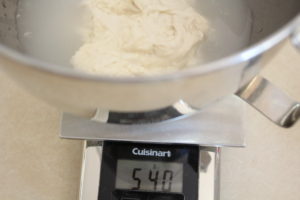
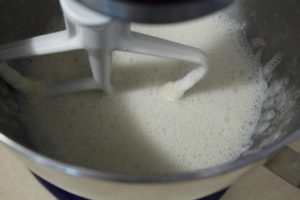
Add water and mix. We want a total of 400 grams of water in the bowl. Right now, it’s a mix of flour and water, but we know from the math above that we have 140 grams of flour in the bowl, no matter how much water in there. So, we also know that if we have 400 grams of water in the bowl, the weight should read 540 grams (400 grams of water plus the 140 grams of flour already in the bowl), so we simply add water until the scale reads 540 grams. You’ll have a different amount, so make a note of the weight of the starter and water. Our starter and water, combined, weigh 540 grams. Now, if you want, you can whisk the starter and water together, but we simply place it in the mixer fitted with the paddle attachment, and mix until soupy.
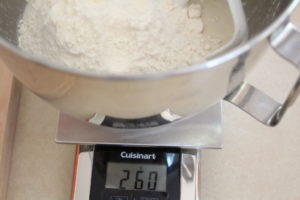
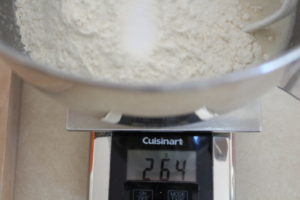
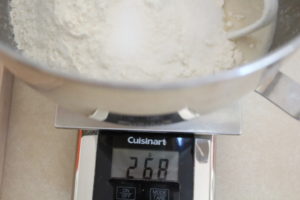
Add dry ingredients. We want to have the same amount of flour and water in our mix. If you’re lucky, your scale might not have reset; if that’s the case, simply add flour until the scale reads 800 grams. If your scale has reset — ours did — simply place the bowl with the starter and water on the on the scale, and press tare to zero. From the previous step, you know how much your starter and water mix weighs (ours was 540 grams); therefore, you need to add enough flour so the total weight is 800 grams. Subtract the weight of the starter and water from 800; that tells you how much flour to add. In our case, we need to add 800 grams – 540 grams = 260 grams of flour. Since our scale is reset to zero, we can simply add flour until it reads 260 grams. The amount you need to add will be different. Once you’ve added that flour, add 4 grams of salt and 4 grams of sugar. We’re finished with all our measuring.
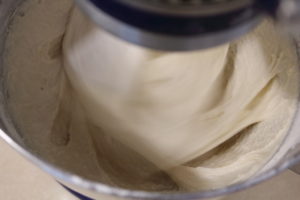
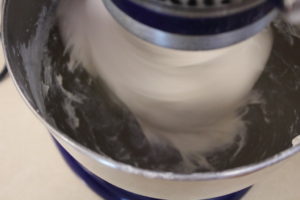
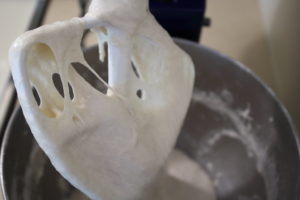
Beat. Place the mixer bowl back on the stand mixer and beat, starting on low, and increasing to medium speed, until the dough looks stringy and pulls away from the sides of the bowl, about 5-7 minutes.
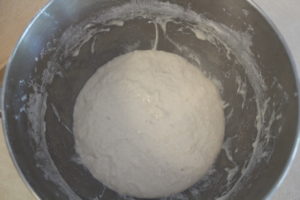
Let rise. Remove the bowl from the mixer, cover with a plate, and let the mixture rise until doubled, about 2-3 hours.
Preheat oven to 450°F. Place a baking stone in the middle of the oven and heat both to 450°F. Get out two pieces of parchment and dust heavily with flour.
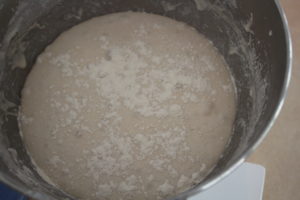
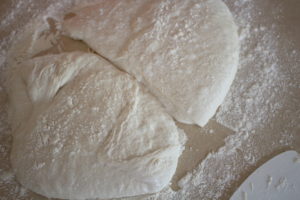
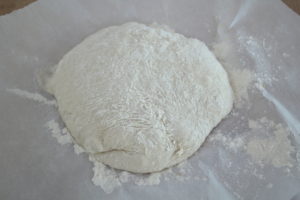
Divide and shape. Unless you’ve worked with high hydration breads in the past, you’ll probably be surprised at how soft and sticky they are. You’ll need a lot of flour to handle it. So, heavily dust your work surface with flour, dust more flour on top of the dough, and coat your hands with flour. Keep the flour nearby, as you’ll probably need more. Dump the dough out onto your floured work surface and use a dough scraper (floured, of course) to cut the dough in half. Working with one piece at a time, grab a corner (we know there really aren’t corners; just grab a piece of dough that’s sticking out) and pull it up and fold it toward the center of the dough. Repeat several more times, then deftly lift and flip that piece of dough onto the prepared parchment. Repeat with the other piece of dough. Let the dough sit while the oven preheats.
Bake. Brush the dough with a bit of olive oil, a sprinkle of rosemary, and a bit of freshly cracked black pepper. Use a pizza peel to slide the dough, parchment and all, onto the baking stone, and bake until golden brown, about 15 minutes. Repeat with the remaining dough.
We definitely like this bread better when it’s made with sourdough starter. As one would expect, it has a more complex flavor — the sour dough starter not only has a variety of wild yeasts, but it also has a variety of microorganisms. All of which produce flavor in your bread. We also think this bread would be good with just a bit of Parmesan cheese on top, or other herbs in place of the rosemary. An easy five-star way to use up leftover sourdough starter.
